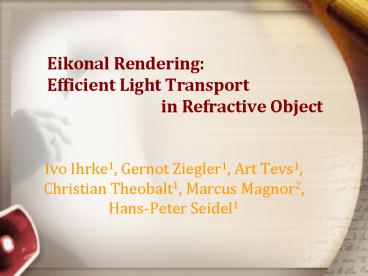Eikonal Rendering: Efficient Light Transport in Refractive Object PowerPoint PPT Presentation
1 / 24
Title: Eikonal Rendering: Efficient Light Transport in Refractive Object
1
Eikonal RenderingEfficient Light Transport
in Refractive Object
- Ivo Ihrke1, Gernot Ziegler1, Art Tevs1, Christian
Theobalt1, Marcus Magnor2, Hans-Peter Seidel1
2
Outline
- Introduction
- Related work
- Image Formation Model
- Light Transport
- Implementation issue
- Result and Discussion
3
Introduction
- Object with complex optical properties
- spatially varying refractive index
- Cause inhomogeneous focusing of light.
- Become visible as beautiful surface and volume
caustic
4
Introduction cont.
- Contribution
- Provide a general framework
- To jointly reproduce the effects below in
real-time on commodity graphics hardware. - Varying refractive index, arbitrary BRDF,
view-independent single-scattering effect,
translucent object in scattering participating
media
5
Related Work
- Approximate refraction effect
- In real-time on GPU Wyman 2005
- On a special processor Ohbuchi 2003
- In a CPU-based ray-tracerWald et al 2002
- Rendering realistic caustics
- off-line and high quality backward
ray-tracingArvo 1986 - Photo mappingJensen et al. 2001
- Scattering
- Subsurface scatteringMerten 2003
- Light propagation
- Eikonal and transport equation , main postulate
of geometric opticsBorn and Wolf 1999
6
Image Formation Model- General Image Formation
- Account for emission, reflection, absorption,
scattering - denote radiance on the ray c that is
scattered, emitted , reflected, into eye. - is background radiance
- is the absorption of light at
position t - xc(t) position vdc/dt ray direction
7
General Image Formation -cont.
- ? Ls due to inscatter
- Lr reflected into eye
- Le emitted into eye
- ? is the Fresnel reflection factor
- Locality of Lc
8
General Image Formation -cont.
- p the scattering phase function
- dE? local differential radiance
- fr BRDF term
9
IFG-Simplified Image Formation
- Too complex to evaluate in real-time
- Make two assumption
- Light originates from a discrete number of light
source - For each point, only a discrete number of
incoming light ray
10
Light Transport
- Including two parts
- Propagation of viewing ray
- Light transport
- Governing equations are derived from
- Ray equation of geometric optic
- Born and Wolf 1999
11
Light Transport- Viewing Ray Propagtion
- The equation describe the motion of a light
particle in a field n of inhomogeneous
refractive indices - Derived from eikonal equation
- The motion of a particle along the gradient of
the eikonal solution
12
Viewing Ray Propagtion -cont.
- Rewritten as below
- Use Euler forward scheme
13
Light Transport -Modeling Light Sources
- Model a light source with
- Three dim. vector field of local light direction
l(x) - Scalar filed of differential irradiance value
- Use adaptive wavefront tracing to compute l(x)
and
14
Modeling Light Sources -cont.
- A wavefront is an iso-surface of constant travel
time of light. - Light ray is normal to wavefront.
15
Modeling Light Sources -cont.
- l(x) ?
- traveling directions of the particle
- ?
- area of wavefront patches
16
Modeling Light Sources -cont.
- The pre-computation of the three-dim. light
distribution includes 4 steps - Wavefront propagation
- Irradiance computation
- Wavefront refinement
- Voxelization of the local light direction and
differential irradiance values
17
Wavefront Propagation
- The propagation of light is similar to eye rays
propagation. - re-parameterize the former equation.
18
Irradiance Computation
- The irradiance computation is based on the
intensity law of geometric optics. - In an infinitesimal tube of ray the energy stays
constant. - ?
19
Wavefront Refinement and Voxelization
- To obtain a continuous volumetric representation
of the light distribution - Wavefront patches have to voxelized.
- If a patch area slides through a voxel without
touching it with one of its corner, - This patch will be unsampled.
- ? Use wavefront refinement
20
Implementation Issue
- 1.Input Data Format
- Input scenes are stored as a set of 3D volume
textures. - Refractive index distributions can be derived
directly from the implicitly function of the
object - Some texture also contain spatial varying RGB,
boundary indicator , BRDF parameter
21
Implementation Issue -cont.
- 2.Light Simulator
- Wavefront is represented as a particle system.
- Use the 2D-parameterization of the patch list
texture to produce a - planar wavefront --- directional light source
- Spherical wavefront --- point light source.
- The propagation of the wavefront through the
scene and logging into the output 3D volume is
perform in 3 subsequent steps.
22
Implementation Issue -cont.
- Patch List Update
- For every time step, update the patchs position
and direction. - Patch List Voxelization
- Into 3D-output volume for irradiance and
direction - Patch List Tessellation Analysis
- Divergence tessellation stay below a minimum
sampling bound - Patch termination apply energy threshold to
eliminate the patch - 3. View Renderer
23
Video time
- Taking a break and see the video!
24
Conclusions
- We present a fast and versatile method to render
a variety of sophisticated lighting effects in
real time. - The pre-computation took around 90 minutes for
600 frames. - AMD Dual Core Athlon 2.6GHz, Nvidia GeForce 8800
GTX and 768 of video ram - 25fps at a resolution of 800 x 600 pixels

